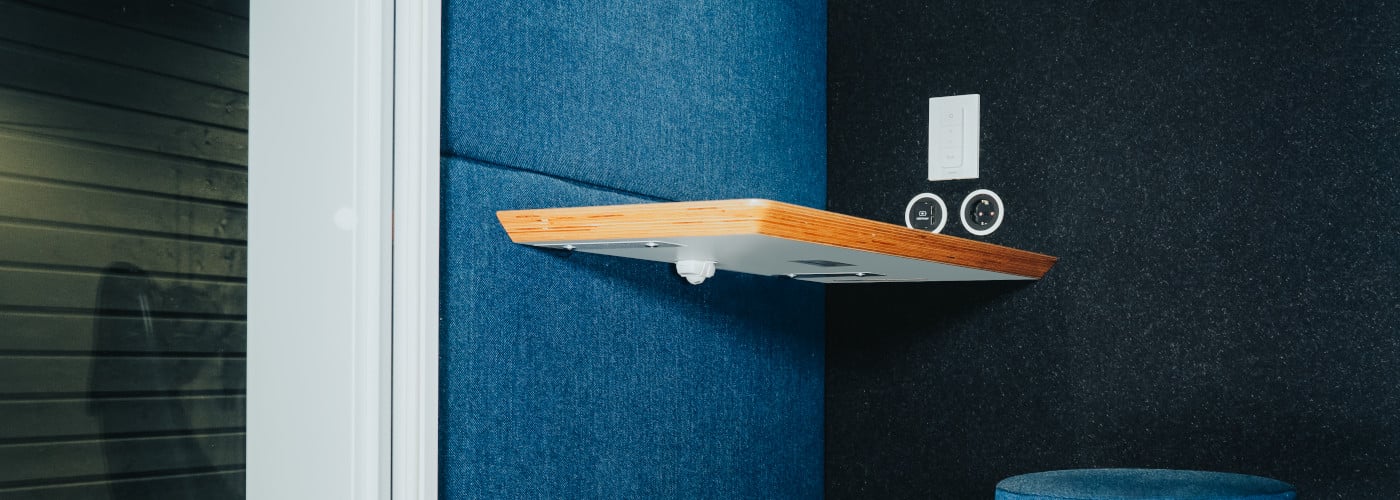Optical Vs. PIR Sensors

VergeSense is the industry leader in providing enterprises with a true understanding of their occupancy and how their offices are actually being used.
Office sensors are fast becoming a standard in today’s workplace. These are devices with varying capabilities that are deployed with the intention of monitoring a range of functions— some are used to gather human behavior data from the office environment, while others detect and monitor different aspects of the workplace such as space usage, occupancy, air quality, and heating and cooling, among others.
In the workplace, sensor technology can often be used in conjunction with IoT systems, to collect data and generate insights, make building management more efficient, spaces smarter, and the employee experience more seamless.
There are a myriad of workplace sensors to choose from, including optical sensors, PIR sensors, entryway sensors, and motion sensors, or lighting-integrated sensors.
Among the most common are PIR and optical sensors, which we will delve into in this article. After reading this comparison between PIR and optical sensors, you will be equipped to decide which of these sensors your workplace needs.
1. PIR Occupancy Sensors
PIR, or passive infrared sensors, are small sensors that can be mounted under a desk, and are designed to monitor the usage and occupancy of the desk. They are triggered by temperature changes in the immediate environment.
How do PIR sensors work?
When there is no change in heat or movement detected by the sensor, the status (which is represented by either a zero or a one) is set to zero. As the workplace manager, this would be seen as a vacant table or empty conference room. When the sensor detects motion or heat, however, the status changes to one, which indicates that the desk or conference room is now in use.
The Benefits PIR Sensors
1. PIR sensors are cheap
If you’re eager to implement workplace sensors but don’t have a dedicated budget just yet, PIR sensors are a great starting point, as they are relatively cheap and easy to install.
2. The installation process is easy
The installation can be completed in a matter of seconds, making it an accessible option for those who do not have the capacity or resources for a longer-term project.

Fig 1: PIR sensor installed beneath a desk. Source: Haltian
3. PIR sensors protect employee anonymity
A benefit of PIR sensors is that the device is tracking heat and movement, so it cannot identify the person using the space, and consequently does not record any photos or videos of people sitting at the desk. So, it’s safe to say that PIR sensors protect employee anonymity, although you should always double check to see if they are GDPR compliant.
The Drawbacks of PIR Sensors
1. PIR sensors provide inaccurate data
You might not want to invest in PIR sensors if you are under pressure to make high-stakes decisions with your data. A common shortcoming of PIR sensors is that they can provide inaccurate data.
PIR sensors are known for having a limited detection range. Depending on the size of your space and the positioning of your sensor, there may be motion that happens just outside of the area it’s designed to be monitoring. This can lead to incorrect occupancy data for your building or office.
Additionally, because of how sensitive the motion detectors are, bugs or wind can easily interfere with PIR sensors, which cause false alarms or generate inaccurate occupancy data. Powerful wind can also penetrate the sensor mechanism, causing problems with the sensor’s ability to properly detect movement.
PIR sensors may have low or unstable voltage, which is something that needs to be triple checked and rectified prior to installation, as it is very challenging to make changes later.
Usually, these sensors report to have an accuracy rate of 92% when measuring active occupancy, which is greatly compromised when someone is stationary for an extended period of time. And keep in mind, active occupancy only accounts for 50% of the total occupancy picture.
2. PIR sensors cannot measure passive occupancy
Passive occupancy refers to a space that is in-use, even if a human isn’t present at that very moment. As previously mentioned, this now accounts for 50% of your occupancy. So, what does this mean?
Consider this: Jane walks into the office and selects her desk for the day. She spends the morning at her desk working on a presentation, and at 11:00 am she joins her colleagues for a monthly review meeting. So now, is her desk occupied or free? Well, that depends. Is she coming back? Are there signs that she’s coming back? In this case, it looks like she left her coat and backpack, and so she will be.
How well would PIR sensor technology analyze and understand this scenario?
To a typical PIR sensor, when Jane walked away that space would be identified as available, which is clearly incorrect. Imagine if this incorrect occupancy data was integrated with a desk booking application designed to auto-release desks when no one is present. While Jane is at her meeting, someone looking for a seat might check to see what’s free and select where Jane has been sitting.
That would be a terrible experience for Jane, as well as the other employee who intended to claim Jane’s desk. It would be an even more confusing and inaccurate picture of the occupancy story for you. This poor experience can also apply to room bookings, and any other spaces leveraging utilization data for reservations.
2. Optical Sensors
Optical sensors are powered by anonymous computer vision technology, which means that these sensors go beyond just counting people in spaces and actually understand how these spaces are being used. Optical sensors have evolved from simple people counting to providing context of what is happening within spaces, which is what makes them the backbone of an occupancy intelligence platform.
How do optical sensors work?
Optical sensors detect when spaces are actively and passively occupied by identifying humans and common objects that are associated with human presence. These sensors generate low-resolution imagery on the device, which is significantly cheaper than camera technology and uses ELS technology (edge-processing, low-res, secure) to keep employee privacy protected.
Pros of Optical Sensors
1. They’re accurate
Optical sensors use sophisticated AI to process the data they capture, which constantly improves their understanding of every space over time.
They can integrate to all the software and hardware in your company’s tech stack, like your IWMS, CAFM, desk and meeting room booking software, tablets, and keycard readers. This allows for occupancy data captured by the optical sensor to be combined with other space data from the rest of your tech stack.
Because these sensors leverage a holistic understanding of the people, objects, characteristics, and interactions happening within workplaces, they can provide contextualized utilization insights unlike any other sensor technology.
Most importantly, these sensors can measure passive occupancy, which constitutes 50% of space utilization. That’s substantial. To put that into perspective, that means if your PIR sensors are telling you that 100 of your 500 desks are being used right now, it’s likely missing another 100 passively occupied desks. In other words, 200 of your desks are actually in use at that moment.
How does that kind of inaccuracy impact your utilization metrics? It’s the difference between 20% utilization and 40% utilization.
As mentioned in the previous example about Jane, optical sensors would be able to detect that although Jane has left the room, she’s still using it because of the presence of her coat and backpack. Therefore, the sensors would provide the correct data to the room and desk booking platform, and Jane’s desk would be reserved for her until she returned.
2. They’re private and secure
The optical sensor converts light into an image, which then uses AI to derive information from that image. Optical sensors use E.L.S technology, which stands for Edge processing, Low resolution, and Secure. This means information gleaned from the low resolution image is automatically anonymized, and no personal information is derived, captured, or stored.
Optical sensors use E.L.S technology, which stands for Edge processing, Low resolution, and Secure. This means that the low resolution image is captured, and all processing of that image happens on the device - not in a centralized database. So, it’s automatically anonymized, AI derives information from it, it’s destroyed, and only the 1’s and 0’s are sent into the user-interface. No personal information is derived, captured, or stored.
Optical sensors are used as one pillar of an occupancy intelligence platform. These platforms are built for mature, enterprise businesses where security and privacy are a strict requirement. As a result, most optical sensors and their associated platforms are GDPR CPIA, ISO/IEC 27001 and SoC2 Type II compliant.
The Drawbacks of Optical Sensors
1. Longer installation process than PIR sensors.
Optical sensors are a lot more complex than PIR sensors, and therefore the installation process can take a bit longer. This, however, depends on the square footage of space in your portfolio as well as the number of sensors being deployed. Installation and deployment is typically completed between 60 and 90 days.
2. A misconception of the implications of using a camera
Optical sensors can give rise to the misconception that employees are being monitored through cameras in the ceiling.
This alarming fallacy can dissuade the adoption of optical sensor technology in the workplace. These fears often stem from a lack of knowledge of how these sensors work, and therefore providing transparency when introducing the technology to your company is paramount.
The reality of smart offices today is that nearly every intelligent device, from Google Home to Alexa, has some form of in-built optical technology that drives accuracy like no other. It is the fear of where the data is going that comes in the way of these investments.
Should I choose PIR sensors or Optical Sensors for my office?
Here are some characteristics of enterprises for which PIR sensors might be the right fit:
If you are a small to medium sized enterprise in need of a baseline understanding of workplace occupancy, PIR sensors are likely the right choice for you.
- A limited budget for workplace investments
- In need of a baseline understanding of occupancy and just getting started gathering workplace data
- A predominantly remote work model
Here are the characteristics of enterprises for which optical sensors might be the right fit:
However, if you are a workplace, real estate or facilities leader trying to gain a true understanding of how and when your portfolio and spaces are actually used so that you don't have to compromise between cost and employee experience, an occupancy intelligence platform coupled with optical sensor technology is the right choice for you.
- A global real estate portfolio with multiple space types and thousands of employees
- The need to solve for complex problems such as employee experience, portfolio right-sizing, space design and planning, and facilities operations
- A hybrid workforce
Want to have a conversation with a workplace expert about gathering occupancy and utilization data within your spaces?
VergeSense is offering two new solutions focusing on Portfolio and Space Optimization. Each solution is part of the Occupancy Intelligence Platform: a unified, secure, and private platform that integrates with your workplace applications and provides portfolio and space insights and decision support.
- Occupancy Intelligence for Portfolio Optimization allows real estate leaders to reduce costs by correctly sizing for where they need more office space and where they need less.
- Occupancy Intelligence for Space Optimization allows workplace and facilities leaders to improve experience by using real-time occupancy data to adapt their most valuable spaces with confidence.
